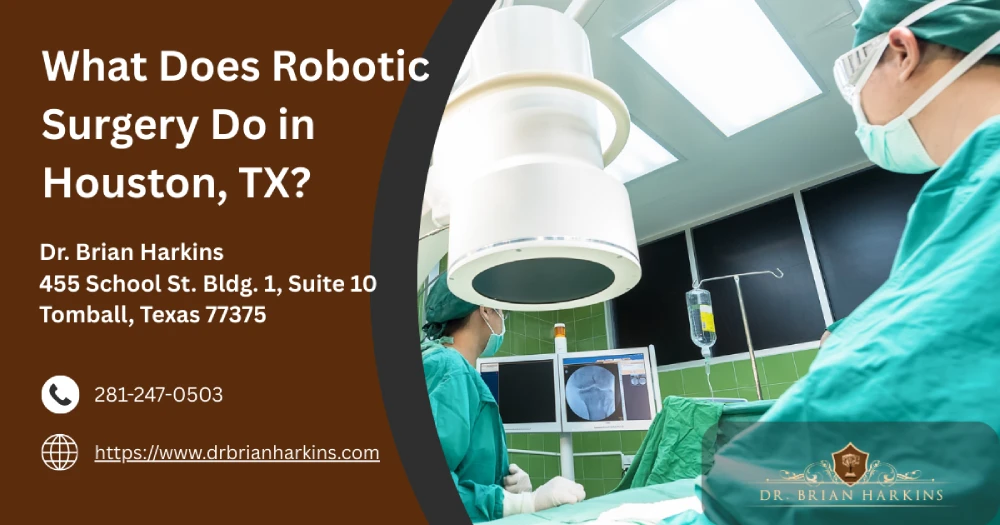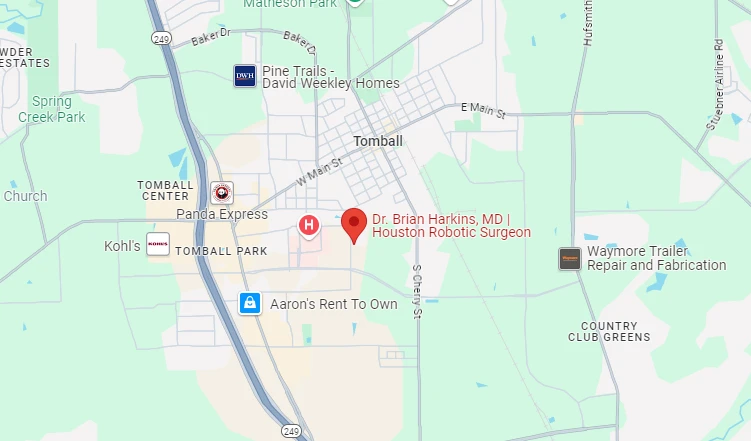
Curious about robotic-assisted procedures and wondering, what does robotic surgery do in Houston, TX? Simply put, robotic surgery enhances a surgeon's precision and control during minimally invasive procedures. Using advanced robotic systems like the da Vinci Xi, Houston surgeons can perform complex operations through small incisions, leading to faster recovery, less pain, and minimal scarring. This cutting-edge approach is widely used across specialties including cardiac, urologic, gynecologic, bariatric, and colorectal surgery, giving patients safer options and quicker returns to daily life.
Robotic surgery in Houston, TX, utilizes a next-generation robotic surgical system to assist the surgeon during a wide array of minimally invasive procedures. The computer-enhanced platform translates your doctor’s hand motions into precise movements at the robotic arm tips, all visualized through a high-definition 3-D camera. Compared with traditional open surgery or even standard laparoscopic techniques, this robotic-assisted approach often means smaller incisions, less pain, and a faster trip back to normal life.
Forget sci-fi tropes—robotic-assisted surgery is about amplifying human talent, not replacing it. Within major Houston healthcare networks and at every top-tier medical center in the Texas Medical Center, platforms such as the da Vinci Xi, Versius, and ROSA empower surgeons to treat everything from hernia repairs to heart valve disease.
The robot features four to six slender arms holding instruments that mimic a human wrist. Your surgeon sits at a console, manipulating hand controls that filter tremor and scale motion. High-definition optics magnify tissue up to ten times, enabling safer, less invasive dissections.
| Surgical Specialty | Typical Robotic Procedures | Average Hospital Stay | Return to Normal Activity |
|---|---|---|---|
| Cardiac | Mitral valve repair, totally endoscopic coronary artery bypass | 3 – 5 days | 3 – 4 weeks |
| Urology | Robotic prostatectomy, partial nephrectomy | 1 – 2 days | 2 – 3 weeks |
| Gynecology | Hysterectomy, advanced endometriosis excision | Same-day – 1 day | 1 – 2 weeks |
| General Surgery | Inguinal or ventral hernia repair, cholecystectomy, bariatric sleeve | Outpatient – 1 day | 1 – 2 weeks |
| Colorectal | Low anterior resection, colectomy | 2 – 4 days | 3 – 4 weeks |
The Texas Medical Center boasts world-class teams offering keyhole heart procedures, such as totally endoscopic coronary bypass, through tiny ports between the ribs—often without a sternotomy.
Robotic prostatectomy is now the gold standard for localized prostate cancer because the robotic surgical system helps preserve pelvic nerves, enhancing continence and sexual health.
Robotic platforms help gynecologic surgeons remove fibroids or treat endometriosis deep in the pelvis with less blood loss and quicker discharge.
Whether repairing a complex hernia or performing a bariatric sleeve, the surgeon gains 3-D visibility and wrist-like dexterity that are impossible with conventional tools.
Expect labs, imaging, and a pre-anesthesia consult. Breathing exercises and carb-loading drinks up to two hours pre-op can improve healing.
Most patients sip liquids within hours and walk the same day. Pain is typically controlled with non-opioid medication by day two, supporting a shorter stay than open surgery.
All surgery carries risk—bleeding, infection, or anesthesia issues. However, minimally invasive surgery generally lowers these odds. Houston teams monitor vitals closely and can convert to traditional open surgery instantly if required.
Ask how many robotic cases your surgeon performs annually; higher volumes correlate with smoother outcomes.
Look for facilities accredited by the Joint Commission or MBSAQIP—true hallmarks of leaders in robotic surgery.
Top programs offer nurse navigators, dietitians, and physical therapists to streamline your recovery journey.
Total hospital billing for robotic procedures in Houston ranges from $15,000 – $85,000, influenced mostly by OR time and case complexity—not by the robot itself.
In Houston, TX, robotic surgery allows surgeons to operate with enhanced precision, using robotic arms that translate their hand movements into highly controlled actions. This means smaller incisions, less blood loss, and faster recovery times for patients. Whether for hernia repair, prostate surgery, or heart valve procedures, robotic-assisted techniques help Houston patients experience fewer complications and a quicker return to normal activities.
Many studies show lower blood loss, fewer complications, and shorter hospital stays compared with open surgery, but outcomes depend on surgeon skill and case complexity.
Most incisions are 8 mm—about the width of a pencil eraser—and fade to faint lines within months.
If pain is minimal and you’re off narcotics, you may resume driving in 7 – 10 days, pending surgeon clearance.
Houston teams keep traditional instruments ready and can switch to an open approach in minutes if needed.
Yes, select Houston medical centers employ scaled-down robotic platforms for children. Surgeons must have specialized pediatric training, and cases are chosen carefully to ensure safety. Benefits mirror adult outcomes—smaller scars and quicker recovery—yet decisions prioritize growth considerations and the child’s overall health status.
Both are minimally invasive, but the robotic approach offers wrist-like flexibility and 3-D vision absent in conventional laparoscopy. That added dexterity helps tackle complex suturing or dissections near critical structures. For straightforward gallbladder removal, laparoscopy may suffice, while intricate pelvic or thoracic work often favors the robot.
Data show comparable—or occasionally superior—durability versus mesh repairs done by open or laparoscopic means. The robotic surgical system enables meticulous mesh placement and layered closure, which can reduce recurrence. Long-term success still hinges on healthy weight management and avoiding heavy lifting during early recovery.
Early in a surgeon’s learning curve, setup can add minutes. Once the team is proficient, total operative times often equal or beat open procedures because improved visualization speeds dissection and suturing. Furthermore, shorter hospital stays typically offset any marginal increase in OR minutes.
Seek board certification, fellowship training, and at least 50–100 completed robotic cases in your procedure type. Many Houston healthcare systems list surgeon volumes publicly. Also review patient testimonials and complication statistics to ensure your doctor ranks among the area’s leaders in robotic surgery.
High BMI can complicate any operation, but the robot’s precision often benefits bariatric or obese patients by enabling smaller incisions through thicker tissue layers. Surgeons may recommend pre-operative weight management, yet an elevated BMI rarely disqualifies someone outright from robotic options.
No. While Houston’s major academic hospitals and flagship community centers have multiple robots, smaller facilities may still rely on laparoscopic or open techniques. Confirm the specific robotic surgical platform and model—da Vinci Xi, Versius, or ROSA—during your consultation.
Yes, but suitability depends on your condition. Some emergencies or extensive cancers require traditional open surgery. Discuss the rationale with your surgeon, and consider a second opinion from a high-volume robotic specialist to explore all minimally invasive possibilities.
Most operations employ general anesthesia to keep you fully asleep and immobile, ensuring controlled ventilation while the abdomen is insufflated. Advances such as shorter-acting agents and opioid-sparing protocols support a smoother wake-up and faster discharge.
Light walking begins within hours post-op. Low-impact activities—stationary biking or gentle yoga—may resume after two weeks, while heavy lifting and high-intensity workouts usually wait four to six weeks. Always follow personalized guidelines from your surgical team to prevent strain on healing tissues.


Dr. Brian Harkins is a renowned surgeon specializing in advanced, minimally invasive, and robotic surgical techniques. With a dedication to innovation and personalized patient care, he has transformed countless lives by delivering exceptional outcomes.

I want a website like this, where do i start?